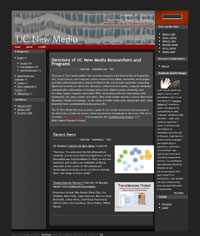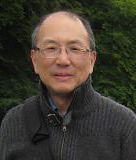 URL: http://ucnewmedia.english.ucsb.edu URL: http://ucnewmedia.english.ucsb.edu
Role: Founder.
The area of “new media studies” has recently emerged at the intersection of humanities, arts, social science, and computer science research into digital, networked technologies and their cultural implications. Research fields in this area include humanities computing, digital and network art, electronic literature, critical internet studies, computer-mediated communication, information technology and society, digital textual scholarship, text encoding, human computer interaction (HCI), networking protocols, data mining, data visualization, GIS, game studies, and others. New media studies also has a reverse time-arrow dimension: “media archaeology,” or the study of earlier media (oral, manuscript, print, early industrial) from a postindustrial media perspective.
The UC New Media Directory provides a guide to new media researchers and programs in the University of California system, which has invested strategically in this area. (This site is currently under construction. It is managed by the Transliteracies Project, a UC Multi-campus Research Group.)
|
Suggested Citation: UC New Media Directory. Home page. University of California. Retrieved [Date of access, e.g., 27 September 2006]. <http://ucnewmedia.english.ucsb.edu/>
Course site: http://transcriptions.english.ucsb.edu/curriculum/courses/overview.asp?CourseID=290
Course Description: This course consists of two parts:
 I. Romantic Landscape (7 weeks) This part of the course attends to the specificity of Romantic landscape during the so-called British “long 18th century” or (in art history) “great century”–i.e., to the unique contribution of Romanticism to an era when in great part landscape was art and art was landscape. Rivaled perhaps only by the novel, with which it was on intimate terms, landscape was the epic of the times. It was the familiar of that other great Romantic epic form: autobiography. This part of the course concentrates on the writings of the Wordsworth circle and the paintings and watercolors of John Constable and J.M.W. Turner. These materials are developed against a backdrop that includes 18th-century writers and painters, the aesthetic theories of the picturesque and sublime, and the history and theory of “descriptive” genres (including georgic and locodescription).
I. Romantic Landscape (7 weeks) This part of the course attends to the specificity of Romantic landscape during the so-called British “long 18th century” or (in art history) “great century”–i.e., to the unique contribution of Romanticism to an era when in great part landscape was art and art was landscape. Rivaled perhaps only by the novel, with which it was on intimate terms, landscape was the epic of the times. It was the familiar of that other great Romantic epic form: autobiography. This part of the course concentrates on the writings of the Wordsworth circle and the paintings and watercolors of John Constable and J.M.W. Turner. These materials are developed against a backdrop that includes 18th-century writers and painters, the aesthetic theories of the picturesque and sublime, and the history and theory of “descriptive” genres (including georgic and locodescription).
II. New Forms of Landscape (3 weeks) Whether developed in conceptual, metaphorical, or virtual form, navigable space–and often specifically landscape–is important to the contemporary artistic imagination.  The course will conclude by making the transition through late-nineteenth-century landscape photography (Carlton Watkins, Eadweard Muybridge) to modern and contemporary forms of landscape imagination, including “land art” and new-media art. Materials include: the work of Robert Smithson, James Turrell, Andy Goldsworthy, Richard Long, Charlotte Davies, John Klima, and Sue Thomas as well as such forms as computer games and satellite imagery. The wager of the course is that we can learn something about the use of landscape as a major form of the social imaginary if we juxtapose Romantic poets and artists walking through nature and contemporary poets and artists browsing or navigating the networks.
The course will conclude by making the transition through late-nineteenth-century landscape photography (Carlton Watkins, Eadweard Muybridge) to modern and contemporary forms of landscape imagination, including “land art” and new-media art. Materials include: the work of Robert Smithson, James Turrell, Andy Goldsworthy, Richard Long, Charlotte Davies, John Klima, and Sue Thomas as well as such forms as computer games and satellite imagery. The wager of the course is that we can learn something about the use of landscape as a major form of the social imaginary if we juxtapose Romantic poets and artists walking through nature and contemporary poets and artists browsing or navigating the networks.
The course is supported by an Online Image Gallery (login required).
“The Agrippa Process: ‘Agrippa (A Book of the Dead)’ in the Age of Web 2.0.” Conference on “The Extreme Contemporary.” Center for the Study of the Novel. Stanford University. 12 January 2007.
- Conference publicity announcement.
- Draft of paper — for conference respondents only (version 1.1d, posted Jan. 10, 2007; only very minor fixes in this latest version) (140 Kb; Adobe .pdf format) (requires login): Liu.pdf
- Slideshow accompanying the paper — for conference respondents only (6.26 Mb; PowerPoint .ppt format) (requires login): Liu-slides.ppt
- Slideshow accompanying the paper — for conference respondents only (Web version of above PowerPoint show for Internet Explorer only) (requires login): Liu-slides.htm
 URL: http://ucnewmedia.english.ucsb.edu
URL: http://ucnewmedia.english.ucsb.edu


